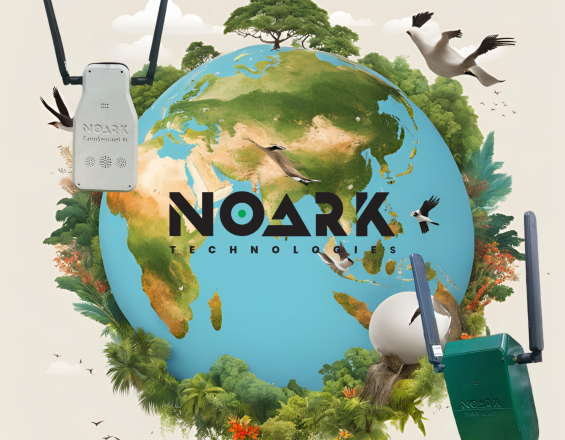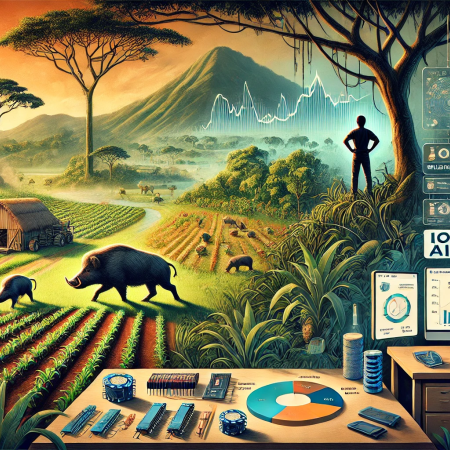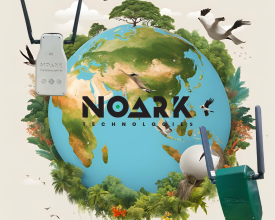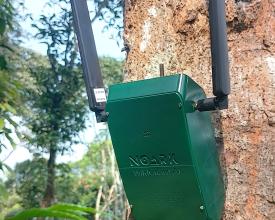
Empowering Conservation with AI-Powered Monitoring and Early Warning Systems.

WildGuard AI is an Edge AI-powered sensing system by NOARKTECH designed to protect biodiversity and reduce climate-related risks in forest and farm landscapes. Using IIoT (Industrial internet of things) devices connected via LoRaWAN (Long Range Wide Area Network) and LTE (Long Term Evolution), it detects wildfires, heatwaves, and human-wildlife conflict in real time. It combines bioacoustic AI (e.g., elephant and hornbill calls), temperature, and gas sensors to detect anomalies early.
Paired with PAMS (Protected Area Management & Security System), a dashboard for real-time alerts, analytics, and visualization, the system supports proactive action. Piloted in India’s Western Ghats, it helped reduce crop loss, fire spread, and wildlife threats. WildGuard AI and PAMS enable scalable, affordable, and sustainable nature-based intelligence for climate resilience and conservation.
Tech4Nature Award
WildGuard AI, developed by NOARKTECH, is a cutting-edge Edge AI and IIoT-based solution deployed in remote forested and agrarian regions to detect ecological threats in real-time. The system integrates bioacoustic sensors to identify species-specific vocalizations (e.g., elephants, hornbills), along with temperature, gas (CO, VOCs), and humidity sensors to detect wildfires, heatwaves, and other climate-related anomalies. The devices are connected via low-power LoRaWAN and LTE networks, making them ideal for low-infrastructure and off-grid environments.
The data is processed on-device using Edge AI models for rapid response and minimal bandwidth usage. This is then integrated into PAMS (Protected Area Management and Security System), a web-based dashboard that offers real-time alerts, predictive analytics, and spatial visualization for forest departments, farmers, and disaster management teams. PAMS enables early action, resource optimization, and better planning. Innovations include decentralized architecture, multi-modal sensing, and compatibility with parametric insurance systems for climate resilience.
- TBI NIT Calicut: : Providing funding and support for the prototype development.
- Kerala Startup Mission (KSUM): Offering financial grants and mentorship for productization.
- iHub IIT Mandi: Supporting prototype deployment through funding and technical guidance.
Context
Challenges addressed
WildGuard AI addresses three interlinked challenges in ecologically sensitive regions:
Environmental – Increasing frequency of wildfires, deforestation, and biodiversity loss due to climate change and human encroachment.
Social – Escalating human-wildlife conflict, especially with species like elephants and hornbills, impacting lives, safety, and cultural landscapes of local and Indigenous communities.
Economic – Crop losses, forest-based livelihood disruptions, and rising disaster recovery costs.
Our Edge AI-powered monitoring system uses real-time acoustic and environmental sensing to detect threats early, enabling faster response, habitat protection, and ecosystem resilience.
Location
Process
Summary of the process
The building blocks of NOARKTECH’s WildGuard AI ecosystem are tightly interconnected, creating a unified, resilient solution for real-time environmental monitoring and response. The WildGuard AI sensor suite—comprising bio-acoustic, chemical, and climate sensors—generates hyperlocal data that feeds directly into the Edge AI models deployed on-device, enabling instant threat detection without relying on constant connectivity. These AI-processed alerts are transmitted via LoRaWAN, ensuring coverage even in remote forest regions. All collected and filtered data seamlessly integrates into the PAMS dashboard, where forest departments, researchers, and community stakeholders can visualize and act on emerging patterns using predictive analytics. The dashboard is co-designed with users, ensuring the system is both intuitive and effective. Meanwhile, community engagement serves as the foundation, supporting sensor deployment, data interpretation, and long-term sustainability. Together, these components build a robust loop: real-world sensing → localized processing → reliable communication → informed decision-making—creating measurable conservation impact and scalable early warning capabilities.
Building Blocks
WildGuard AI Sensor Ecosystem (Bio-Acoustic + Chemical + Climate Sensing)
NOARKTECH’s WildGuard AI integrates bio-acoustic microphones, air quality sensors (CO, VOC), and hyperlocal climate monitors to detect wildlife movement, forest fires, and ecological disturbances. This system enables real-time environmental intelligence for conservation, climate resilience, and human-wildlife conflict prevention.
Enabling factors
- Deployment of rugged, energy-efficient sensors suited for field conditions
- Scientific validation in collaboration with academic and environmental institutions
- Pilot deployments across Western Ghats and Northeast India
Lesson learned
- Sensor effectiveness improves with community-informed placement strategies
- Continuous environmental calibration enhances precision over time
- Environmental durability must be prioritized during design and testing phases
Edge AI + LoRaWAN Infrastructure
NOARKTECH’s WildGuard AI uses on-device Edge AI models and LoRaWAN communication to process data locally and transmit alerts even in low-connectivity regions. This low-power, scalable network allows instant wildfire detection, animal tracking, and real-time environmental monitoring.
Enabling factors
- Flexible integration of open-source LoRaWAN technology and compact AI models
- Low latency communication ensures rapid response in emergencies
- Collaboration with embedded system experts for optimized hardware-software synergy
Lesson learned
- Local capacity building ensures long-term reliability and system maintenance
- Intelligent alert routing and data filtering are essential to avoid signal noise
- Redundant communication strategies strengthen system resilience
PAMS Dashboard + Community Co-Design
The Protected Area Management System (PAMS) by NOARKTECH is a centralized, intuitive dashboard aggregating data from edge devices. Co-designed with forest officials and community members, it delivers predictive analytics, real-time alerts, and supports evidence-based decision-making.
Enabling factors
- User-focused design through participatory field engagements
- Integration of remote sensing data and satellite overlays for broader context
- Offline functionality and multilingual interface increase usability across regions
Lesson learned
- Adaptive interfaces tailored to specific users (rangers, farmers, analysts) increase engagement
- Alert fatigue can be reduced by dynamic thresholding and contextual relevance
- Sustained use requires continued training and localized support channels
Resources
Impacts
Environmental:
NOARKTECH's innovation has significantly improved efforts to conserve biodiversity and protect ecosystems by gathering than 300,000 points of data in trial runs which helps in detecting poaching and unauthorized logging on as well, as preventing loss of biodiversity effectively. Its ability to monitor events, in time has reduced the impact of wildfires and land degradation while also helping to avert landslides. Additionally the chemical sensors keep track of air and water quality which supports pollution management and fosters the health of ecosystems.
Social:
Our technology helps decrease conflicts, between humans and wildlife by providing notifications in time to improve community safety and promote peaceful coexistence. The engagement of Indigenous Peoples and nearby communities in monitoring activities equips them with resources and expertise to care for the environment. Localized climate information aids, in forecasting and addressing health hazards related to pollution and severe weather conditions to enhance adaptability and overall wellness of individuals.
Economic:
LoRaWAN-enabled devices ensure cost-efficient, scalable operations, even in remote areas. With accurate hyperlocal climate data, improving productivity and income stability. Early warnings for wildfires, landslides, and other hazards prevent economic losses, supporting proactive risk management and resource optimization.
Beneficiaries
The beneficiaries include local communities, indigenous peoples, farmers, conservationists, protected areas, government bodies, NGOs, and conservation organizations. They benefit from biodiversity protection, reduced conflicts and improved livelihoods.
Additionally, explain the scalability potential of your Solution. Can it be replicated or expanded to other regions or ecosystem?
NOARKTECH's solution is designed to be scaled and adjusted for areas and environments because of its modular structure and the use of various technologies, like bio acoustic and chemical sensors as well as Edge AI and LoraWAN connectivity options. This system can be customized to tackle issues unique to each region including biodiversity decline conflicts, between humans and wildlife and the impacts of climate change.
Its use of energy long distance connections allows for implementation even, in distant or limited resource regions. The centralized dashboard for Protected Area Management & Surveillance System (PAMS) along with its ability to analyze data makes it a versatile solution for areas as well as rural and conservation areas alike. Furthermore support, from community members guarantees that the technology is aligned with environmental considerations. This boosts its acceptance and efficiency.
NOARKTECH's platform could have a reach. Contribute to conservation and sustainable progress, in different settings like forests and agricultural lands as well, as urban and coastal regions by resonating with local objectives and biodiversity targets.
Global Biodiversity Framework (GBF)
Sustainable Development Goals
Story

The tale of NOARKTECH began with my personal journey—one that intertwined a deep connection to nature with a decade-long career in the tech industry. After working for ten years in technology, I made a bold decision to return to my roots and embrace farming. This transition wasn’t just a career shift; it was a complete transformation in how I perceived the world around me. Living on the farm, I experienced both the awe-inspiring beauty of nature and its growing fragility.
I witnessed firsthand the growing conflicts between humans and wildlife—wild boars destroying crops, forest degradation threatening species, and the escalating impacts of climate change. These weren’t abstract issues—they were part of my daily life. It became clear that my background in technology could be harnessed to solve the very problems I was living through. That moment of clarity marked the beginning of NOARKTECH.
NOARKTECH wasn’t born to merely build new gadgets—it was created to design purposeful systems that protect both ecosystems and the communities that depend on them. It has been a journey of relearning, reimagining, and immersing myself in the complex science of ecological preservation. The mission has always remained clear: build a technology framework that can mitigate human-wildlife conflict, enhance biodiversity protection, and enable nature-positive agriculture.
Today, NOARKTECH is more than just a solution—it’s a living testament to a journey of purpose. It reflects a unique fusion of compassion, resilience, and innovation, born from personal experience and a vision for coexistence. It’s our promise to the planet: to empower people and nature to thrive together in harmony.





